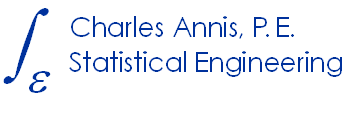IntraOcular Trauma Test (IOTT)
IntraOcular Trauma Test (IOTT)
*(Plot the data. If the result hits you between the eyes,
then it’s significant.)
Using an appropriate probability grid, plot the cdf (cumulative distribution function) data. The data will appear as a straight line on the correct grid. Fortunately, there are two grids that will cover most of the distributions we need, and making additional ones isn’t too complicated.
To make a Normal (or Lognormal) grid notice that the y-axis is in terms of number of standard deviations, although it’s not labeled that way. So the middle of the graph is at y=0 and that corresponds to cdf, \(F(x) = 0.5 = 50\%\). One standard deviation unit up (or down) is \(F(x) = 0.8413\) (or \(0.1587\)). Two units up (or down) is \(0.9772\) (or \(0.0228)\). Three units up (down) is \(9987 \space (0.0013)\). And so on. These values, and intermediate values chosen for graphing purposes, are tabulated everywhere and can be found using MS EXCEL also. If the x-axis is to represent a normally distributed x, then it’s Cartesian. If lognormal is what you want, then the x-axis is logarithmic.
To make a grid for the exponential distribution, we can take advantage of knowing that the exponential distribution is a special case of the Weibull, when the slope parameter, beta, equals one. The Weibull grid is even easier to make than the Normal grids because F(x) has a closed form (unlike the Normal), viz.
\[F(x) = 1 – \exp\big(-(x_i/\eta)^\beta \big)\]
\[\exp\big(-(x_i/\eta)^\beta \big) = 1-F(x)\]
\[-(x_i/\eta)^\beta = \ln\big(1-F(x)\big)\]
\[\beta \ln(x_i/\eta) = \ln\Big(-\ln\big(1-F(x)\big)\Big) = \beta \ln(x) – \beta \ln(\eta)\]
This is a linear equation, \(Y=M X+B\), where \(X=\ln(x)\) and \(Y=\ln(-\ln(1-F(x)))\), with slope of \(M = b\), and intercept = \(-\beta ln(\eta)\). (Remember that \(\beta\) and \(\eta\) are constants for a given fit so \beta \ln(\eta)\) is also a constant.)
The grid then is simply Y=ln(-ln(1-F(x))), and X=ln(x). (Logarithmic x-axis, and log(logarithmic) y-axis.) Notice that the \((0, 0)\) point occurs at \(x=1\) (so that \(\ln(x) = 0\), and \(y= \approx 0.632\), since \(\ln(-\ln(1-0.632))\approx 0\). (The actual value is at \(y=1-exp(-1) \approx 0.6321205588)\)
While several plotting position formulas have been suggested, the following rank position has the useful property that the MLE line goes through the points if the data are adequately described by the model. The rank for the \(i_{th}\) uncensored observation is
\[y_i = (i-0.5)/n\]
where \(i = 1, 2, 3, … n\), and \(n\) is the sample size.
That’s it. You can program EXCEL to do the plots if you don’t have software to do it already.
Note:
Modern statistical methods estimate model parameters by the method of maximum likelihood, which is not a graphical method and thus is not influenced by the choice of plotting formula. Nonetheless, plotting the data is always a good idea because it can indicate problems that might otherwise go unnoticed.

